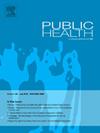Association of chemsex and risk of chlamydia, gonorrhoea, and syphilis infections: a systematic review and meta-analysis
IF 3.2
3区 医学
Q1 PUBLIC, ENVIRONMENTAL & OCCUPATIONAL HEALTH
引用次数: 0
Abstract
Objectives
Chemsex, the use of psychoactive substances to enhance sexual experiences, is increasingly recognized as a public health concern, particularly among men who have sex with men (MSM). This behavior is associated with risky sexual practices, including condomless sex, multiple partners, and prolonged sexual sessions, which may elevate the risk of sexually transmitted infections (STIs) such as chlamydia, gonorrhea, and syphilis. This systematic review and meta-analysis aim to quantify the association between chemsex and these bacterial STIs.
Study design
Systematic review and meta-analysis.
Methods
A systematic search of PubMed, Embase, and Web of Science was conducted to identify studies reporting associations between chemsex and chlamydia, gonorrhea, or syphilis until November 10, 2024. Eligible studies included observational designs with chemsex participants and STI outcomes. Random-effects meta-analyses were performed to estimate pooled odds ratios (ORs) with 95 % confidence intervals (CIs). Statistical analysis was performed by using R software version 4.4.
Results
A total of 13 studies were included across multiple countries. The meta-analysis revealed a significant association between chemsex and syphilis (pooled OR: 1.741, 95 % CI: 1.337–2.267), gonorrhea (pooled OR: 1.784, 95 % CI: 1.428–2.228), and chlamydia (pooled OR: 1.429, 95 % CI: 1.195–1.710). Two studies reporting hazard ratios for gonorrhea (pooled HR: 1.699, 95 % CI: 1.361–2.121) and chlamydia (pooled HR: 1.202, 95 % CI: 0.972–1.487) showed consistent findings. Heterogeneity across studies was minimal for most outcomes (I2 = 0 %), and prediction intervals supported stable effect sizes.
Conclusion
This study confirms that chemsex is significantly associated with an increased risk of bacterial STIs, particularly syphilis and gonorrhea. The findings highlight the urgent need for interventions addressing chemsex behaviors, including harm reduction strategies, STI prevention programs, and culturally competent healthcare services. Future research should focus on standardizing definitions of chemsex, expanding investigations to low- and middle-income countries, and addressing publication bias to ensure global relevance and reliability of evidence.
化学性与衣原体、淋病和梅毒感染风险的关系:一项系统综述和荟萃分析
目的chemsex,即使用精神活性物质来增强性体验,越来越被认为是一个公共卫生问题,特别是在男男性行为者(MSM)中。这种行为与危险性行为有关,包括无安全套性行为、多伴侣性行为和长时间性行为,这可能会增加衣原体、淋病和梅毒等性传播感染的风险。本系统综述和荟萃分析旨在量化化学性与这些细菌性传播感染之间的关系。研究设计:系统回顾和荟萃分析。方法系统检索PubMed、Embase和Web of Science,以确定截至2024年11月10日报告化学性与衣原体、淋病或梅毒之间关联的研究。符合条件的研究包括有化学性别参与者和STI结果的观察性设计。随机效应荟萃分析以95%置信区间(ci)估计合并优势比(ORs)。采用R软件4.4版进行统计分析。结果在多个国家共纳入13项研究。荟萃分析显示,化学性与梅毒(合并OR: 1.741, 95% CI: 1.337-2.267)、淋病(合并OR: 1.784, 95% CI: 1.428-2.228)和衣原体(合并OR: 1.429, 95% CI: 1.195-1.710)之间存在显著相关性。两项报告淋病(合并风险比:1.699,95% CI: 1.361-2.121)和衣原体(合并风险比:1.202,95% CI: 0.972-1.487)的研究结果一致。大多数研究结果的异质性最小(I2 = 0%),预测区间支持稳定的效应量。结论:本研究证实,化学性行为与细菌性传播感染的风险增加显著相关,尤其是梅毒和淋病。研究结果强调了对化学性行为进行干预的迫切需要,包括减少伤害的策略、性传播感染预防计划和具有文化能力的医疗服务。未来的研究应侧重于标准化化学性的定义,将调查扩大到低收入和中等收入国家,并解决发表偏倚问题,以确保证据的全球相关性和可靠性。
本文章由计算机程序翻译,如有差异,请以英文原文为准。
求助全文
约1分钟内获得全文
求助全文
来源期刊

Public Health
医学-公共卫生、环境卫生与职业卫生
CiteScore
7.60
自引率
0.00%
发文量
280
审稿时长
37 days
期刊介绍:
Public Health is an international, multidisciplinary peer-reviewed journal. It publishes original papers, reviews and short reports on all aspects of the science, philosophy, and practice of public health.
 求助内容:
求助内容: 应助结果提醒方式:
应助结果提醒方式:


